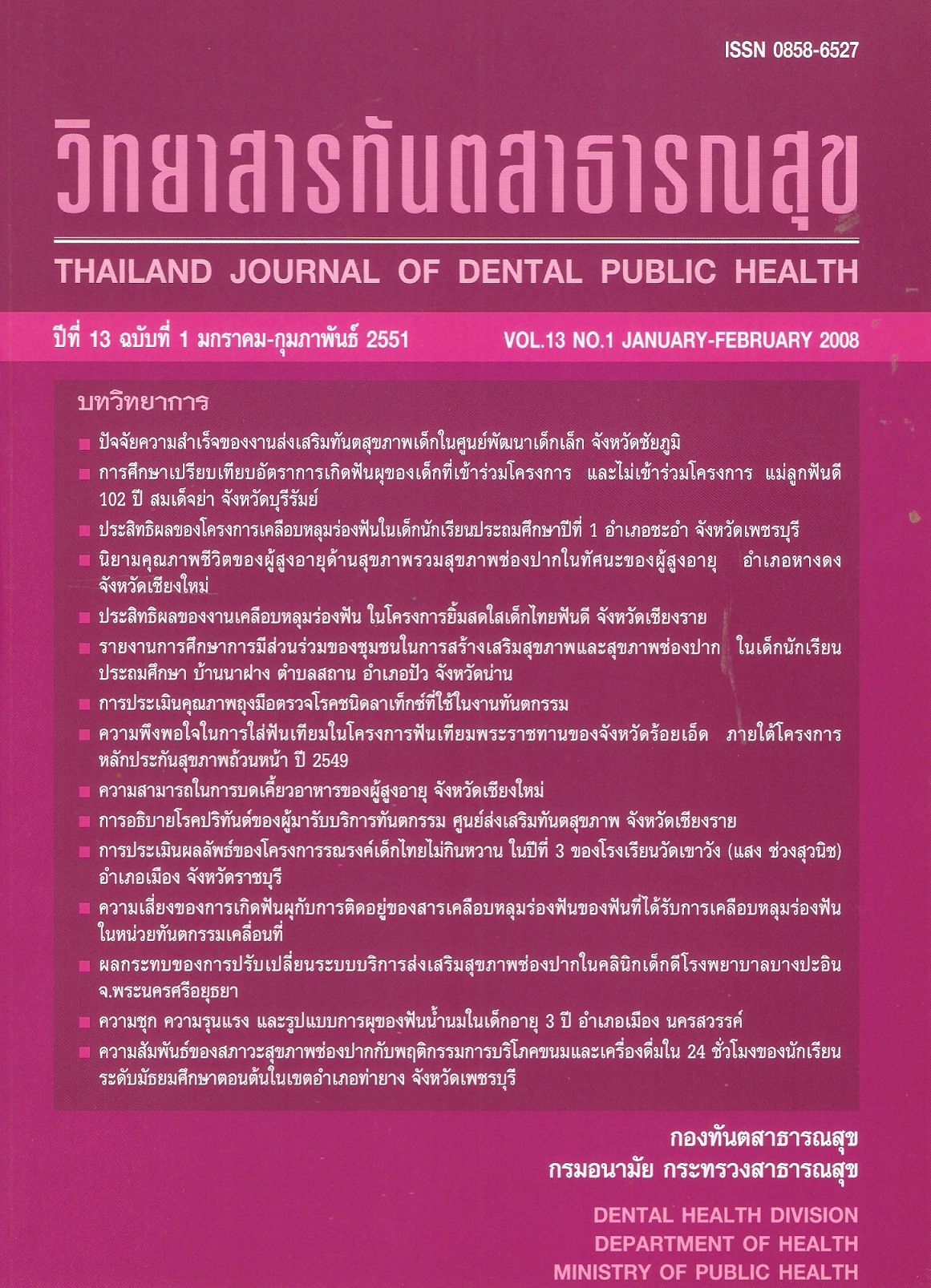Quality Evaluation of Latex Examination Glove for dental use.
Main Article Content
Abstract
The use of latex examination gloves in dental clinic is necessary to prevent infection and protect the dentists and their assistants from direct contact to saliva and blood. Nowadays, it was found that a significant number of rubber gloves are not up to standard safety requirement. The aim of this work is to evaluate the quality of latex examination gloves used in dental clinic of 12 hospitals in Lopburi province. Random sampling of 5 gloves from 4 different boxes from each hospital was carried out for testing of maximum tensile force and elongation at break. The gloves were from 5 companies, all were one year from manufacture date. It was found that the film thickness was 0.09 to 0.12 mm. The maximum tensile force was 9.74 Newton to 16.12 Newton and the elongation at break was 901.11% to 1261.11%. The obtained results were also analyzed by one-way ANOVA and Tamhane's test. The results showed significant different (p=0.05) over Thai industrial standard 1056-2548. The water leakage detection from 200 gloves were 1 to 10. These were quite different but up to standard. Use of gloves within one year from manufacture date and water leakage test from time to time or prior to buying are the suggestions.
Downloads
Article Details
References
2. American Dental Association, Council on Dental Therapeutics. Council on Prosthetic Services and Dental Laboratory Relation. Guildlines for Infection Control in the Dental Office and the Commercial Dental Laboratory : J. Am. Dent Assoc 1985 : 110, 969-972
3. Center for diseases Control. Recommended Infection Control Practice for Dentistry. MMWR, 35: 237-242, 1986
4. Kolstad R. and White R.R.: Disinfection and Sterilization. In Willett, N.P., White R.R., and Rosen S. (eds.). Essential Dental Microbiology. Prentice-Hall International Inc., Connecticut. 1991.pp. 55-65.
5. ปิยพงศ์ วัฒนวีร์ และคณะ. แนวทางปฏิบัติงานทันตกรรมในผู้ติดเชื้อ HIV / ผู้ป่วยโรคเอดส์ และทางปฏิบัติในการควบคุมการติดเชื้อทาง ทันตกรรม ในแนวทางปฏิบัติทางทันตกรรม Clinical practice guideline in dentistry. นนทบุรี กรมการแพทย์ กระทรวงสาธารณสุข พ.ศ. 2543:109-128, 131-149
6. http://en.wikipedia.org/wiki/Rubber_glove
7. http://www.rubberthai.com/newspaper/late_news/2550/July50/05-07-30.htm
8. มาตรฐานผลิตภัณฑ์อุตสาหกรรมของถุงมือ สําหรับตรวจโรค มอก. 1056-2548 สํานักงาน มาตรฐานผลิตภัณฑ์อุตสาหกรรม กระทรวงอุตสาหกรรม
9. วันเพ็ญ ดวงสว่าง, กองรังสีและเครื่องมือแพทย์ กรมวิทยาศาสตร์การแพทย์ “คุณภาพมาตรฐาน ถุงมือทางการแพทย์” ประชุมวิชาการกรม วิทยาศาสตร์การแพทย์ 29 สิงหาคม 2550 ณ. อิมแพค เมืองทองธานี11.A.D.
10. Calvert K.O. Polymer latices and their applications. New York: Macmilan. Publishing, 1982.
11. Roberts and C.A.Brackley, Comfort and frictional properties of dental gloves, J. Dent. 1996 ; 24 (5), 339-343
12. Tinsley D., Chadwick R.G. The permeability of dental gloves following exposure to certain dental materials. J Dent 1997 ; 25(1):65-70.
13. M.A. Baumann, B. Rath, J.H. Fischer and R. Iffland. The permeability of dental procedure and examination gloves by an alcohol based disinfectant. Dent Mat 2000:16:139-44
14. Neal JG, Jackson EM, Suber F, Edlich RF. Latex glove penetration by pathogens: a review of the literature.J Long Term Eff Med Implants 1998;8(3-4):233-40.
15. Seymour R.B., Carraher C.E. Polymer Chemistry: an introduction City:Marcel Dekker, 1992.
16. กันต์นิดา คุณากรปรมัตถ์, อรวรรณ ปัญญจเร,พัชรา พิพัฒน์โกวิท, มโน คุรัตน์, การตรวจหา รูรั่วในถุงมือยาง : ศึกษาวิธีทดสอบและตรวจ คุณภาพของถุงมือ. ว. ทันต 2536; พ.ค.-มิ.ย; 43(3) 150-163 17. บุญนิตย์ บริบูรณ์, จีรพันธ์ พันธุ์วุฒิกร,สร้อยศิริ บริบูรณ์, เจิดกุล โสภาวนิตย์, การ ทดสอบประสิทธิภาพของถุงมือที่ใช้ในทาง ทันตกรรม. ว. ทันต 2536; ก.ค.-ส.ค.; 43(3) 212-217


